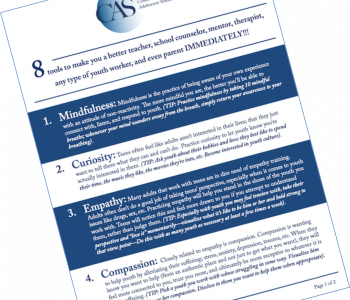

Catharine Hannay
Catharine Hannay is the founder of MindfulTeachers.org and the author of Being You: A Girl’s Guide to Mindfulness, a workbook for teen girls on mindfulness, compassion, and self-acceptance.
4 Ways to Help Teens Cope with Strong Emotions
It’s common for adults to tell youth to “stop overreacting.” That’s usually not very helpful, especially if the adult is yelling at them to calm down! It’s much more effective to be a good role model of skillfully responding, and to teach them what’s going on in their brains and how they can self-regulate when they feel overwhelmed.
Here are four different ways you can help your students or clients (and yourself) learn to skillfully respond to strong emotions.
1: Breathing
Breathing practices are a popular way to practice present-moment awareness or to consciously invoke a relaxation response. Many teens find breath-based meditation helps them calm down and feel less stressed. However, if you work with trauma-impacted youth, it’s important to be very cautious in introducing them to meditation. (See 10 Essential Guidelines for Teaching Meditation to Trauma-Impacted Youth.)
Mindful Breathing
If this seems appropriate for your students or clients, you could have them try mindful breathing for just a minute or two and see how they respond. Remind them that they don’t have to breathe in any special way, just notice the breath going in and out, in and out. It might be helpful to suggest a specific way to focus on the breath: the inhalation, the exhalation, their belly rising and falling, the air blowing through their nostrils onto their upper lip, or the tiny little pause in between the in-breath and the out-breath.
Remind them that “mindfulness is a practice, not a perfect.” When their minds wander, they can just gently bring their attention back to the breath.
Also remind them that they may feel more relaxed afterward, but it’s OK if they don’t. This is a mindfulness exercise rather than a relaxation exercise. The purpose is to practice intentionally focusing their awareness, not to change the way they might be feeling.
Breathing for Relaxation
Some kids misunderstand the recommendation to “breathe deeply” or “take a deep breath.” They take a big gulp of air instead of a slow, gentle inhalation. You might ask them to try a couple of different breaths so they can feel the difference. (Don’t try this if they’re panicking or have a medical condition that impacts their breathing.)
- Quickly take a big gulp of air and blow it out.
- Now take a long, slow breath in and a long, slow breath out.
When I just tried this, I felt anxious during the first breath and the second breath felt soothing. That’s what happens for most people. Our breath tends to be short and shallow when we feel worried, so taking long, slow breaths can help us to feel calm.
There are several more suggested breathing practices in a post at MindfulTeachers.org on ‘Breath-Based Practices for Mindfulness or Stress Reduction’.
2: Knowledge
Many youth find it helpful to understand what’s going on in their brains when they have strong feelings. There’s no need to overwhelm them with a detailed description of every single part of the brain, from the medulla oblongata to the globus pallidus. But it’s important not to be overly simplistic, either.
Some kids are being taught that the thinking part of the brain is “good” and should be used to suppress the “bad” emotional parts, like the amygdalae. (See ‘The Magnificent, Mysterious, Wild, Connected, and Interconnected Brain’) It’s more accurate to say that different parts of our brain work together to do different jobs, so they’re useful in different situations. Sometimes we need to respond quickly to a threat or danger. At other times, we need to think through a situation and plan the most appropriate response. We get into trouble when the wrong parts of the brain take over at the wrong time.
One way to think about the amygdalae is like “our own personal fire alarm, ready to go off whenever we are threatened emotionally or physically” (Popowitz, Grief Recovery for Teens) That’s useful when there’s an emergency, but it’s a problem when the fire alarm doesn’t know when to shut itself off. Imagine what it would be like if an alarm were going off all the time. It would be very hard to concentrate on anything else, and we wouldn’t know when we could relax and when we needed to protect ourselves.
A popular metaphor for this type of reaction is the “lizard brain.” This was originally based on an outdated theory of how the mammalian brain developed from the reptilian brain. But it’s still a very useful metaphor for what happens when we feel threatened. The lizard brain can make us lash out and do or say things we regret. Fortunately, since we’re not reptiles, our sophisticated human brain can help us come up with a more skillful response.
3: Self-Awareness
Dr. Amy Saltzman uses the expression “having your feelings without your feelings having you.” This means that you’re aware of what you’re feeling but “your feelings don’t negatively affect your performance, control your behavior, or have you say or do something that you might regret.” You let yourself feel your feelings “without trying to change them, fix them, or get rid of them” (A Still Quiet Place for Athletes).
The following questions can help your students or clients think about their usual reactions and what they might do differently. Practice skillful self-disclosure in deciding whether it might be appropriate to share your own experiences with Lizard Brain. And use discernment in when to prompt youth to talk about their personal experiences and when to respect their need for safety and privacy.
Has your lizard brain ever turned into Godzilla?
Why were you upset? How did you overreact? What did you say or do?
Were there any signals that your lizard brain was getting out of control?
Have you noticed these signals before?
The next time you start to overreact, what can you do to turn your inner Godzilla into a little baby lizard?
Another way to help your students and clients develop self-awareness is through practicing a type of mindfulness meditation that focuses on observing their own mental processes.
Labelling Thoughts and Feelings
(Please note: As with any type of meditation, please try this yourself several times before attempting to guide others.)
Close your eyes if that’s comfortable for you. You don’t have to focus on anything in particular right now, just notice your thoughts and feelings as they arise.
Give your thought or feeling a name or label, like “angry feeling,” or simply “feeling.” Let go of that thought or feeling. When a new thought or feeling comes along, give it a name, like “hungry sensation” or “memory.” Don’t judge it as good or bad, just observe it and let it go.
When you’re ready, open your eyes (if they were closed) and bring your awareness back to your surroundings.
This type of practice can help youth understand that meditation doesn’t mean trying to completely clear your mind so you don’t have any thoughts. You can’t stop your brain from thinking. That’s its job. Mindfulness meditation is more about becoming aware of our thoughts and feelings so we can see more clearly what’s really going on.
4: Responding, Not Reacting
When you got upset as a kid, did an adult ever tell you to take a deep breath and count to ten? That didn’t really work for me. I remember thinking, “Onetwothreefourfivesixseveneightnineten! What?! I’m still angry!”
Of course, I now realize that the act of counting doesn’t somehow magically make our anger go away. The point is to take a breather so we can calmly choose an appropriate response rather than lashing out in anger.
There are a lot of acronyms for taking a mindful pause, like STOP or PEACE. My favorite is TAP, which I learned from my colleague Dr. Sam Himelstein, the director of the Center for Adolescent Studies.
TAP stands for:
T: Take a Breath
A: Acknowledge
P: Proceed
When you Take a Breath, you pause for a moment before reacting. This can help you avoid doing or saying something you might regret.
When you Acknowledge, you think about what’s going on inside you and around you. For example, if you’re having an argument, you might recognize that you’re feeling angry and frustrated. You might also realize that the other person is feeling the same way.
Now you’re ready to Proceed, taking whatever action seems most appropriate. Sometimes you might decide not to act. There are times when not doing or saying anything can be the most helpful action of all.
Conclusion
As with any type of intervention, use your own best judgment about which of these suggestions might be appropriate for your students or clients. Think about how comfortable they are with you, and with other participants if it’s a class or group. Always give them the option not to share personal information or not to participate in an activity or type of meditation that might be stressful or triggering for them. If you work with trauma-impacted youth, Dr. Himelstein has a very helpful post on 9 Guidelines for Teaching Trauma-Informed Mindfulness to Teens.
Portions of this post were adapted from Being You: A Girl’s Guide to Mindfulness, by Catharine Hannay. © Prufrock Press, 2019. Used with permission. https://www.routledge.com/Being-You-A-Girl-s-Guide-to-Mindfulness/Hannay/p/book/9781618218834
Join the FREE Resilience Community for Helping Professionals to learn more about trauma-informed care, resilience, mindfulness, building relationships, and more! Our community features self-paced courses, a monthly live Zoom call, a weekly live meditation, and an online platform to connect with other providers/professionals in your field.
Related Posts
3 Ways Compassion Can Help Youth Impacted by Trauma
3 Ways Movement Can Help Trauma-Impacted Youth

